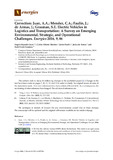Mostrar el registro sencillo del ítem
Electric vehicles in logistics and transportation: a survey on emerging environmental, strategic, and operational challenges
| dc.creator | Juan Pérez, Ángel Alejandro | es_ES |
| dc.creator | Méndez, Carlos Alberto | es_ES |
| dc.creator | Faulín Fajardo, Javier | es_ES |
| dc.creator | Armas, Jesica de | es_ES |
| dc.creator | Grasman, Scott Erwin | es_ES |
| dc.date.accessioned | 2017-11-15T08:00:43Z | |
| dc.date.available | 2017-11-15T08:00:43Z | |
| dc.date.issued | 2016 | |
| dc.identifier.issn | 1996-1073 | |
| dc.identifier.uri | https://hdl.handle.net/2454/26144 | |
| dc.description | Incluye correcciones [Energies 2016, 9(7), 546; doi:10.3390/en9070546] | es_ES |
| dc.description.abstract | Current logistics and transportation (L&T) systems include heterogeneous fleets consisting of common internal combustion engine vehicles as well as other types of vehicles using “green” technologies, e.g., plug-in hybrid electric vehicles and electric vehicles (EVs). However, the incorporation of EVs in L&T activities also raise some additional challenges from the strategic, planning, and operational perspectives. For instance, smart cities are required to provide recharge stations for electric-based vehicles, meaning that investment decisions need to be made about the number, location, and capacity of these stations. Similarly, the limited driving-range capabilities of EVs, which are restricted by the amount of electricity stored in their batteries, impose non-trivial additional constraints when designing efficient distribution routes. Accordingly, this paper identifies and reviews several open research challenges related to the introduction of EVs in L&T activities, including: (a) environmental-related issues; and (b) strategic, planning and operational issues associated with “standard” EVs and with hydrogen-based EVs. The paper also analyzes how the introduction of EVs in L&T systems generates new variants of the well-known Vehicle Routing Problem, one of the most studied optimization problems in the L&T field, and proposes the use of metaheuristics and simheuristics as the most efficient way to deal with these complex optimization problems. | en |
| dc.description.sponsorship | This work has been partially supported by the Spanish Ministry of Economy and Competitiveness (TRA2013-48180-C3-P and TRA2015-71883-REDT), FEDER, and the CYTED Program (CYTED2014-515RT0489). Likewise, we want to acknowledge the support received by the Catalan Government (2014-CTP-00001) and the CAN Foundation (CAN2014-3758 and CAN2015-70473). | en |
| dc.format.extent | 21 p. | |
| dc.format.mimetype | application/pdf | en |
| dc.language.iso | eng | en |
| dc.publisher | MDPI | en |
| dc.relation.ispartof | Energies, 2016, 9(2), 86 | en |
| dc.rights | © 2016 by the authors; licensee MDPI, Basel, Switzerland. This article is an open access article distributed under the terms and conditions of the Creative Commons Attribution (CC-BY) license. | en |
| dc.rights.uri | http://creativecommons.org/licenses/by/4.0/ | |
| dc.subject | Electric vehicles | en |
| dc.subject | Logistics and transportation | en |
| dc.subject | Green vehicle routing problems | en |
| dc.title | Electric vehicles in logistics and transportation: a survey on emerging environmental, strategic, and operational challenges | en |
| dc.type | Artículo / Artikulua | es |
| dc.type | info:eu-repo/semantics/article | en |
| dc.contributor.department | Estadística e Investigación Operativa | es_ES |
| dc.contributor.department | Estatistika eta Ikerketa Operatiboa | eu |
| dc.rights.accessRights | Acceso abierto / Sarbide irekia | es |
| dc.rights.accessRights | info:eu-repo/semantics/openAccess | en |
| dc.identifier.doi | 10.3390/en9020086 | |
| dc.identifier.doi | 10.3390/en9070546 | |
| dc.relation.projectID | info:eu-repo/grantAgreement/MINECO//TRA2013-48180-C3-1-P/ES/ | en |
| dc.relation.projectID | info:eu-repo/grantAgreement/MINECO//TRA2015-71883-REDT/ES/ | en |
| dc.relation.publisherversion | https://dx.doi.org/10.3390/en9020086 | |
| dc.relation.publisherversion | https://dx.doi.org/10.3390/en9070546 | |
| dc.type.version | Versión publicada / Argitaratu den bertsioa | es |
| dc.type.version | info:eu-repo/semantics/publishedVersion | en |




